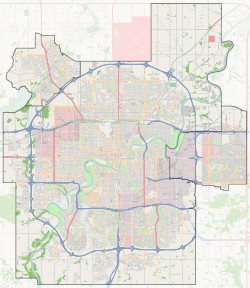King Edward Park, Edmonton
King Edward Park is a residential neighbourhood on south east Edmonton, Alberta, Canada. The neighbourhood was originally annexed by Edmonton in 1912.
King Edward Park | |
|---|---|
Neighbourhood | |
 King Edward Park Location of King Edward Park in Edmonton | |
| Coordinates: 53.516°N 113.453°W | |
| Country | |
| Province | |
| City | Edmonton |
| Quadrant[1] | NW |
| Ward[1] | 11 |
| Sector[2] | Mature area |
| Government | |
| • Mayor | Don Iveson |
| • Administrative body | Edmonton City Council |
| • Councillor | Mike Nickel |
| Area | |
| • Total | 1.4 km2 (0.5 sq mi) |
| Elevation | 672 m (2,205 ft) |
| Population (2012)[5] | |
| • Total | 4,238 |
| • Density | 3,027.1/km2 (7,840/sq mi) |
| • Change (2009–12) | |
| • Dwellings | 2,245 |
The neighbourhood is bounded on the north by Whyte Avenue, on the east by 71 Street and on the south by 76 Avenue. To the west, the neighbourhood overlooks the Mill Creek Ravine. Whyte Avenue provides access to the night life and shopping in Old Strathcona as well as the north campus of the University of Alberta.
The University of Alberta Faculté Saint-Jean campus is located immediately to the north of King Edward Park in the adjoining neighbourhood of Bonnie Doon, as is the Bonnie Doon Shopping Centre.
The community is represented by the King Edward Park Community League, established in 1921, which maintains a community hall, outdoor rink and tennis courts located at 85 Street and 77 Avenue.[6][7]
Demographics
In the City of Edmonton's 2012 municipal census, King Edward Park had a population of 4,238 living in 2,245 dwellings,[5] a -3% change from its 2009 population of 4,371.[8] With a land area of 1.4 km2 (0.54 sq mi), it had a population density of 3,027.1 people/km2 in 2012.[4][5]
Residential development
According to the 2001 federal census, residential development in King Edward Park began before the end of World War II. One residence in eight (12.5%) were built before 1946. Just under half (46.4%) of all residences were constructed between the end of the war and 1960. Another one in eight residences (11.8%) were built during the 1970s. The remaining one in ten residences (9.5%) were built after 1980.[9]
The most common type or residence in the neighbourhood, according to the 2005 municipal census, is the single-family dwelling. These account for approximately three out of every five (57%) residences. Another one in four (24%) of all residences are duplexes.[10] The remaining one residence in five (19%) are rented apartments in low-rise buildings with fewer than five stories. Just over half (52%) of all residences are owner-occupied and just under one half (48%) of all residences are rented.[11]
Population mobility
The population in the neighbourhood is comparatively mobile. According to the 2005 municipal census, one in five (19.1%) of all residents had moved within the previous twelve months. Another one in five (22.4%) of all residents had moved within the previous one to three years. Only two out of every five (43.6%) of all residents had lived at the same address for five years or longer.[12]
Schools
There are two schools in the neighbourhood. Donnan Elementary Junior High School is operated by the Edmonton Public School System. St. James Catholic Elementary School is operated by the Edmonton Catholic School System.
Surrounding neighbourhoods
References
- "City of Edmonton Wards & Standard Neighbourhoods" (PDF). City of Edmonton. Archived from the original (PDF) on May 3, 2014. Retrieved February 13, 2013.
- "Edmonton Developing and Planned Neighbourhoods, 2011" (PDF). City of Edmonton. Archived from the original (PDF) on September 4, 2013. Retrieved February 13, 2013.
- "City Councillors". City of Edmonton. Retrieved February 16, 2014.
- "Neighbourhoods (data plus kml file)". City of Edmonton. Retrieved February 13, 2013.
- "Municipal Census Results – Edmonton 2012 Census". City of Edmonton. Retrieved February 22, 2013.
- "Board Meetings". King Edward Park Community League. Retrieved October 10, 2017.
- Kuban, Ron (2005). Edmonton's Urban Villages: The Community League Movement. University of Alberta Press. ISBN 9781459303249.
- "2009 Municipal Census Results". City of Edmonton. Retrieved February 22, 2013.
- http://censusdocs.edmonton.ca/DD23/FEDERAL%202001/Neighbourhood/KING%20EDWARD%20PARK.pdf
- Duplexes include triplexes and fourplexes.
- http://censusdocs.edmonton.ca/C05002/MUNICIPAL%202005/Neighbourhood/KING%20EDWARD%20PARK.pdf
- http://censusdocs.edmonton.ca/C05022B/MUNICIPAL%202005/Neighbourhood/KING%20EDWARD%20PARK.pdf